Delta
Delta
Flight 1235- 12:05pm
Harrisburg to Atlanta
Right now, my first flight is almost over and we will soon land in Atlanta. I should be on my way to Atlanta. But I am not on that flight. I am sitting in Harrisburg International Airport (Canada counts).
IFSA-Butler sent everyone multiple emails in the months leading up to departure about visas. Each email was clear and concise, and I reread everyone to make sure there was nothing else I had to do. So, it was surprising (and very stressful) when the boarding agent would not allow me on the plane because I didn't have a visa. I told him I didn’t need one and showed him the documents from IFSA-Butler. Nope. He needed something from the Costa Rican government. So I called IFSA-Butler and my advisor told me the same thing every email said. I didn’t need a visa because I would apply for a tourist visa after landing in San Jose and then apply for an extension of it.
I told the agent this, but he needed official documentation. I relayed the message that he could call the Costa Rican Consulate and they would verify what I was saying. That wasn't his responsibility (I'd like to point out here that if I called and tried to tell him what they said, he would have had to speak with them to verify it, meaning it technically was his responsibility). As everyone was boarding, one kind stranger showed the agent the website of the Costa Rican Embassy saying that you did not need a visa to enter the visa and you would apply for a visa after landing. He said that the date of my departure was after the 90-day tourist visa expired. I repeated that I would get an extension in Costa Rica and it was impossible for me to have a tourist visa before arriving in Costa Rica (from what IFSA-Butler told me).
By the time my advisor got me documentation from Costa Rican immigration and emailed it to me, it was too late. Oh, and it was in Spanish and they would have had to find a way to translate it since I would not be able to. And my bag was on the plane.
So here I am, sitting in Harrisburg International Airport after figuring out how I would get to Costa Rica. Everything is taken care of now after many phone calls and my flight is tomorrow at 3:34pm out of Washington, D.C. But my back won't be back until 5ish and I'm waiting for my parents to comeback.
So I will conclude by quoting my travel agent at Advantage Travel (IFSA's travel agency), "Delta can go pound salt."
More Posts from Simplyphytoplankton and Others
NSF cancels grant reviews due to WH executive order
The National Science Foundation (NSF)—the major funding agency for basic science—has canceled all grant review panels this week to comply with an executive order from the new administration. This is where independent panels of scientists discuss grant proposals they’ve reviewed for scientific merit and recommend which projects get funded to NSF project managers. A LOT of work goes into setting up and scheduling grant reviews. It will take time to reschedule these panels, delaying key decisions for many promising projects. This will wreak havoc on science grant funding for months to come.
Put simply, this action along with the halting of NIH-funded grants are blatant and reckless political attacks on science, from an administration that seeks blinding loyalty.

None Like It Hot
By Joylette Portlock
July. Long known across the U.S. for fireworks, barbecues, and a desire to stay cool any way we can. Whether it’s air conditioning, swimming pools, beaches or popsicles, the dog days of summer are often reminders that as humans, our comfort depends on an experienced ambient temperature roughly somewhere between 59 and 77 degrees (Fahrenheit).
But what if, instead of 77, it’s a full 40 degrees more: 117 degrees, like it was in California on July 6? Or 105, like it was in Japan last week? Then, it’s more than an issue of comfort; our lives depend on finding a way to stay cool, and in fact more than a hundred people have perished in heat-related deaths globally already this year.
Life in this new age, the Anthropocene, is marked by many things, including a human-caused increase in global heat, commonly referred to as global warming, or climate change. Risk from heat (or wildfires, or floods) is no longer something we have to rely on the overwhelmingly strong scientific consensus about global warming to tell us; every year, climate change impacts are becoming more and more obvious to everyone, whether you have a degree in climate science or not.
Weather and climate are different. Weather is what happens on a day-to-day basis. Climate is the range of weather that we expect and consider normal (i.e., summer is hot) – but normal is changing.

Photo: Graph showing the amount of CO2 in the atmosphere and human population from We Are Nature, on display until September 2018.
We’re now up to over 400 consecutive warmer-than-average months and counting. Carnegie Museum of Natural History’s collections, which span more than 140 years, can help show these shifts in many ways. One of the most important things we can do is to make connections and show the relevance between the basic scientific principles underlying natural phenomena and the evidence all around us; between what’s happening globally and what’s happening locally.

Photo: The growth of plants collected today versus 100 years ago in the same locations, shown in We Are Nature, corroborates the observation of increasingly earlier springtime by documenting earlier maturation of these species.
The globe’s increasing heat is a result of fossil fuel use, food production, and our land use practices. We need energy and food, of course; but it’s critical that we recognize that the systems we impact also impact us. It’s not just our actions, but our interactions with the world around us that are the story. To understand what’s happening and improve our interactions with nature, we have to look at the big picture, and work to meet our needs in ways that minimize disruption to the overall system.
As summer heat waves get longer, more numerous, and more intense (and it seems the whole world is on fire, with deadly fires everywhere from California to Greece to inside the Arctic Circle) one connection is obvious: our need to be cool.
Joylette Portlock, Ph.D., is associate director of science and research at Carnegie Museum of Natural History. She is also executive director of Communitopia, a nonprofit focused on climate change communication, and holds many other roles in the community.

#4—Fun Facts for World Whale Day
Whales are the biggest creatures to ever live on the earth. The largest whale, the blue whale, can be over 90 feet long. The sperm whale, on the other hand, may not be the biggest whale, but it has the biggest brain to have ever existed on Earth.
Learn more about how whales grew to such massive sizes here.
Photo: Smithsonian Institution
Trip to the Osa Pennisula
Trip
Rocks
Mangrove
Stolen
On Friday at around 5:50 am., we left for our first IFSA-Butler organized trip. The bus drive was hours long, but we made stops for breakfast and to see indigenous artifacts. We stopped at the Parque de las Esferas. Here, we saw large spherical rocks that were shaped by Costa Rica’s indigenous peoples hundreds and thousands of years ago. They shaped the rocks by placing them in streams or rivers and used smalls rocks of different shapes to hit them. They were used to make maps of the stars, commerce, and many other things. Unsurprisingly, over the years many myths have been created about their origins and purposes. Some people say that they were made by UFOs or gods.
Later after lunch, we got a boat tour of the Térraba-Sierpe Mangrove, the largest mangrove in Costa Rica. We saw many species of birds: Baltimore Orioles, turkey buzzards, woodpeckers, various species of herons, and many more as well as more wildlife like a Jesus lizard (but we did not see it walk on water as it was on a tree branch) and different species of mangroves such as the red and black mangroves. After about an hour and a half boat ride, we got to the resort called the Corcovado Adventure Tent Camp. After we were settled in, we went to the beach for a little bit. After dinner, we were told to go back to our tents and make sure that everything was still there. All of my stuff was still in our tent, but when I returned to the central pavilion, I learned that the guys in the tent next to ours had both of their bags stolen, including a wallet, a laptop, an EpiPen, and most of their clothing. After about 45 minutes, a group of us went on a night walk that lasted about an hour. When we returned, Rodney, our program director, had an announcement to make. He decided that since one of the thing’s stolen was an EpiPen for an allergy to bees and the student did not have another one with him, we would leave on Saturday right away breakfast, instead of continuing with the rest of the trip as planned and returning to Heredia Sunday night. On our way home Saturday, we stopped at a bridge over el río Tárcoles to look at the crocodiles that gather in the river below.
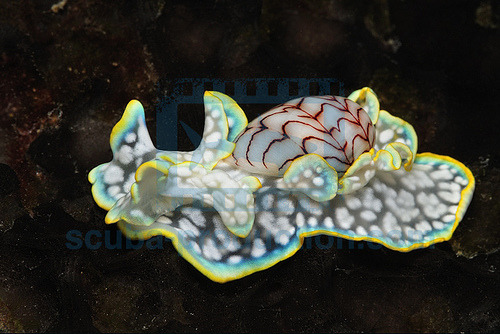
To post about the miniature melo (Micromelo undatus) may seem a bit odd, as it is not a nudibranch but a closely-related sea snail! Its thinly-calcified shell is easily seen covering half of its back and is patterned with dazzling brown-red lines, a stark contrast to the blue, white-spotted body below. It lives in many tropic waters, whether that be Japan or Florida, and reaches about 3cm in length. It eats polychaete worms, and uses their toxins as its own.

Baby loggerhead turtle at home in the sargassum in the Gulf Stream current, where it will spend roughly 5 years, finally being large enough that many animals won’t be able to eat! Sea Turtles have a very difficult life, most of which never make it to maturity and reproduce! Our own existence here on earth as a species is responsible for the death of many beautiful creatures including the sea Turtles, due to mistakes of the past! We have the knowledge, technology and some the drive to fix this, but will we make necessary changes to put our beautiful planet into a sustainable direction? I MOST DEFINITELY WILL! Please join me as our planets future and all creatures are dependent on it! Be the change the world needs! @jim_abernethy #beautiful #babyturtle #gorgeous #cute #precious #underwater #saveturtles #saveoceans (at Jim Abernethy’s Scuba Adventures & Marine Life Art Gallery)
Why Octopuses Could Never Disappoint
These cephalopods, who telegraph their moods by color changes and solve problems by using tools, have surprised me again and again.
And now it’s happened again. An octopus has astonished me.
This time, it’s a common octopus caught on camera in South African waters by a dive team for the documentary Blue Planet II, currently airing on BBC America in the United States.
The action is dramatic. A pyjama shark seizes the octopus. Just as the situation begins to look dire, the octopus stuffs the shark’s gills shut using its sinuous arms, making it impossible for the shark to breathe — until the shark releases it.




Hatfield Marine Science Center:
Sashay the Pacific Giant Octopus Gets Released Sashay, our stunning and extremely friendly Visitor Center octopus was released back into the wild on November 26th. After being gently introduced into the Yaquina Bay, she temporarily crawled onto land. This gave her human fans a final opportunity to say goodbye.
This type of behavior has not been seen at any of our previous releases and was an unforgettable moment for all who witnessed it. While it was difficult to bid this beautiful animal adieu, we want our octopuses to have the opportunity to reproduce and finish their lives in the wild. We hope you enjoy these photos!
Photos by Volunteer James Upton

From walking around Lake Louise, Alberta.
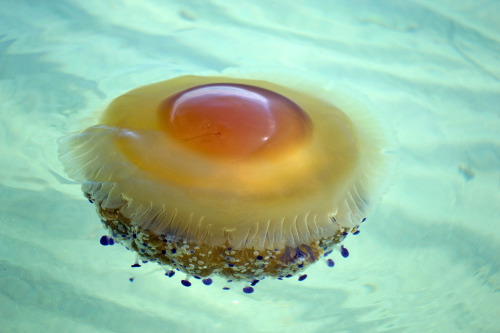

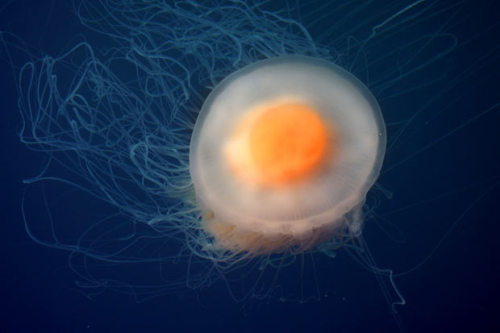
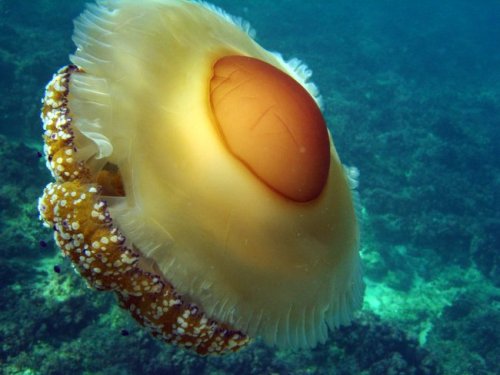
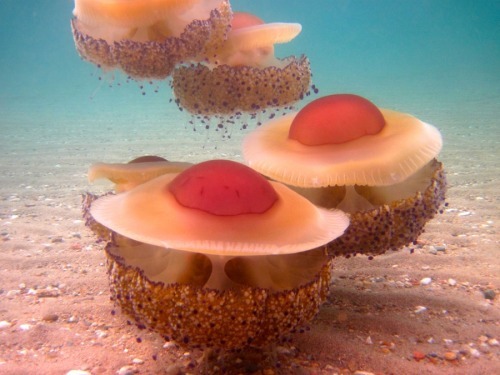
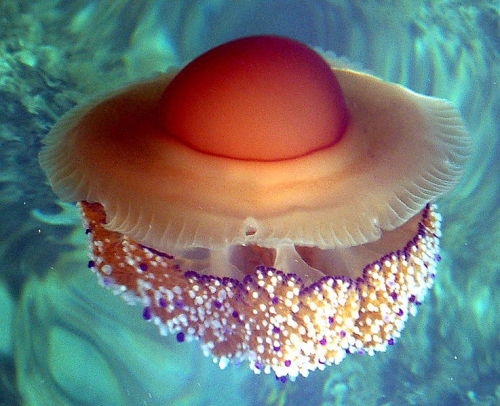
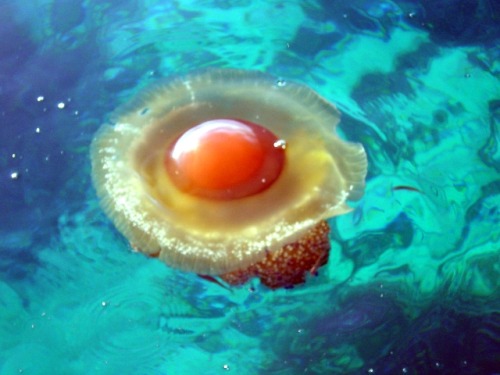
Fried Egg Jellyfish Are Kind of Adorable – & That’s No Yolk.
There are two species that hold the whimsical title of “Fried Egg Jellyfish”: Phacellophora camtschatica and Cotylorhiza tuberculata though the two are quite different from each other in all aspects beside appearance.
Phacellophora camtschatica is a huge jelly that prefers colder waters. It’s bell can reach up to 2 ft across and its dozens of tentacles reach over 20 ft long! If you don’t think this floating egg creature looks very menacing, you’d be right. It has a very weak sting and many small crustaceans take advantage of the jelly by riding on its bell (breakfast to go…?) while snatching up extra food.
Cotylorhiza tuberculata is a much smaller jellyfish that hangs out in warmer waters. It only reaches about 35 cm in diameter, so don’t go for this Fried Egg Jelly if you want a big breakfast. Unlike most jellyfish, C. tuberculata can swim on its own, without relying on the currents for movement. It’s sting (if you can even call it that) is so feeble that it has very little to no effect on humans at all. I mean, it does look like a breakfast food, after all… how powerful could it be?
-
 ididitforthedogs liked this · 9 years ago
ididitforthedogs liked this · 9 years ago -
 simplyphytoplankton reblogged this · 9 years ago
simplyphytoplankton reblogged this · 9 years ago

Blog dedicted to phytoplankton. Phytoplankton are microscopic organisms that are responsible for half of the photosynthesis that occurs on Earth. Oh, and they look like art... Follow to learn more about these amazing litter critters! Caution: Will share other ocean science posts!Run by an oceanographer and phytoplankton expert. Currently a postdoctoral researcher.Profile image: False Colored SEM image of Emiliania huxleyi, a coccolithophore, and the subject of my doctoral work. Credit: Steve Gschmeissner/ Science Photo Library/ Getty ImagesHeader image: Satellite image of a phytoplankton bloom off the Alaskan Coast, in the Chukchi SeaCredit: NASA image by Norman Kuring/NASA's Ocean Color Web https://earthobservatory.nasa.gov/images/92412/churning-in-the-chukchi-sea
158 posts